The video shows ESA’s Cluster flight control team at the ESOC mission control centre, Darmstadt, Germany, performing recovery operations on all four spacecraft following an eclipse.
The Cluster satellite quartet, launched in 2000, no longer have working batteries, so the team must power each spacecraft off before entry into eclipse and power them back on, in a controlled way, after eclipse exit.
Due to the seasonal alignment of the four satellites’ orbits with the Sun and Earth, Cluster will experience two eclipse seasons each year, one that lasts three weeks around February/March, where the eclipses are short (taking place at pericentre), and another in August/September, where the eclipses are long (at apocentre).
After power down, the spacecraft are booted up in their default ‘factory’ configuration (everything is reset!) and each must be fully re-configured back to an operational mode. All the necessary commanding is mostly performed automatically under direct supervision of spacecraft controllers and operations engineers.
The whole sequence takes, currently, just over two hours with the spacecraft being configured in parallel using two ground station antennas.
During eclipse seasons, the most of the scientific instruments are not used, except for two field sensors called FGM and EFW (one each for magnetic and electric).
Cluster is one of Europe’s most successful astrophysics missions ever, and the four craft are delivering the most detailed information ever about how the Sun’s solar wind affects our planet in three dimensions.
More information

